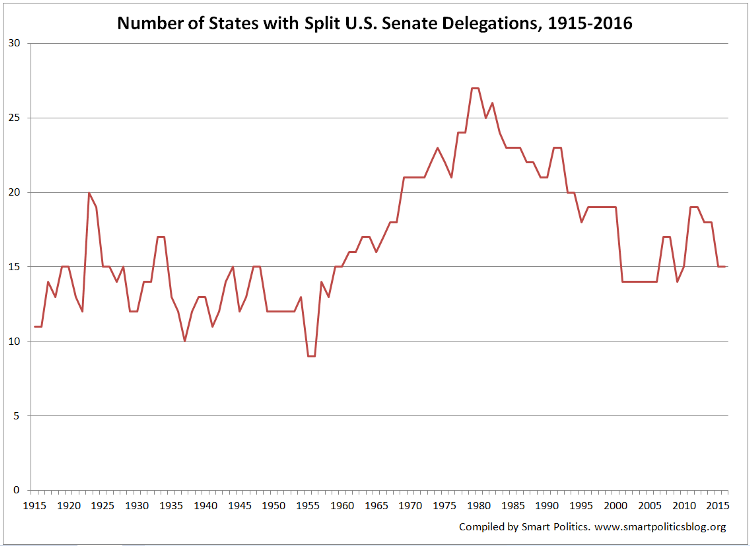115th Congress Could Have Fewest Split US Senate Delegations in History
If the nation’s six most competitive seats flip in 2016, the upper legislative chamber will tie its mark for the lowest number of states with split delegations in the direct election era

Races for the U.S. Senate, however, can sometimes buck these trends with voters in even deep blue or deep red states electing members from a minority party in the state, such as Democrat Mark Begich winning Alaska in 2008, Republican Mark Kirk winning Illinois in 2010, and Democrat Heidi Heitkamp winning North Dakota in 2012.
That said, only 15 of the 50 states currently have split delegations serving their residents in the chamber (U.S. Senators identifying with different political parties): Colorado, Florida, Illinois, Indiana, Maine, Missouri, Montana, Nevada, New Hampshire, North Dakota, Ohio, Pennsylvania, Vermont, West Virginia, and Wisconsin.
That number is nearly half what it was in 1980 and, after Election Day this November, it could reach a record low.
A Smart Politics analysis finds that the 115th Congress will likely have its lowest number of states with split U.S. Senate delegations since the 1950s and, if the six most competitive seats flip this November, the chamber will tie the mark for the lowest number in the direct election era.
The 15 split U.S. Senate delegations currently serving in the 114th Congress has already declined from the previous two Congresses of 19 states in the 112th (2011-2012) and 18 states in the 113th (2013-2014).
But a review of the most competitive races on the ballot in 2016 finds that number is likely to drop even further after 2016 with each of the most likely Democratic and Republican pick-up opportunities poised to create homogeneous partisan delegations in those states.
For starters, each of the six most likely states for Democratic gains would create all-Democratic delegations: in Florida, Illinois, New Hampshire, Ohio, Pennsylvania, and Wisconsin.
While there are fewer opportunities for pick-ups on the Republican side, the GOP’s best chances are in Nevada and Colorado – where the party already holds one seat.
If just two of these eight states flip this November, the chamber will see its lowest number of split delegations since 1958 when 13 states were represented by members from different parties during the second year of the 85th Congress: Arizona, Colorado, Delaware, Idaho, Illinois, Massachusetts, Michigan, Minnesota, Nevada, Ohio, Pennsylvania, Wisconsin, and Wyoming.
The all-time record low during the direct election era was recorded during the 84th Congress from 1955-1956 when just nine states had split U.S. Senate delegations: Arizona, Delaware, Illinois, Massachusetts, Michigan, Minnesota, Nevada, New York, and Wyoming.
The 115th Congress can tie that mark if six of these aforementioned highly competitive states flip in 2016.
One common feature of the U.S. Senate during years in which there have been fewer than 15 split U.S. Senate delegations is that one party has usually held a substantial seat advantage over the other – with an average of 16 seats across the 39 years with 14 or fewer such state delegations.
In other words, when the chamber has seen a low number of split delegations it has generally been due to the fact that one of the two parties has been dominating at the ballot box across the country, racking up pairs of victories across several states.
For example, when Democrats held 66+ U.S. Senate seats from 1935 through 1942 with a 38+-seat advantage over the GOP, the number of split delegations was limited to between 10 and 13 states during this span.
However, that is not the case today: Republicans hold only a 54 to 44 seat advantage over the Democrats (excluding independents in the Democratic caucus), with that number likely to decrease after 2016.
The largest number of states with split delegations in the U.S. Senate during the direct election era occurred during the 96th Congress (1979-1980).
During those two years a majority of states – 27 – did not have the same party hold both of its senate seats: Alaska, Arizona, California, Colorado, Connecticut, Delaware, Idaho, Illinois, Indiana, Iowa, Maine, Maryland, Mississippi, Missouri, New Hampshire, Nevada, New York, North Carolina, North Dakota, Oklahoma, Rhode Island, South Carolina, South Dakota, Tennessee, Texas, Virginia, and Vermont.
At least 20 states had split delegations for a 26-year stretch from 1969 through 1994. The only other year 20 split delegations was reached was in 1923.
Follow Smart Politics on Twitter.


I gather the (partisan) composition of Senate delegations through the decades refers only the results of elections taken concurrently with the House, and exclude stand-alone special elections (e.g. 1 of 2010 in MA), gubernatorial appointments, and mid-session party switches.
The data does include movement outside of the normal election cycle. So, for example, the 13 split delegations in 1958 in the 85th Congress is down from 14 in 1957 after the appointment in West Virginia of Republican John Hoblitzell in January of 1958 (to join GOP Senator W. Chapman Revercomb).